模块18.集合
1
2
3
4
5
6
7
8
9
10
11
12
13
14
15
16
17
18
19
20
21
22
23
24
25
|
模块17重点回顾:
1.wait和notify
a.wait:线程等待,在等待过程中释放锁,需要其他线程调用notify唤醒
b.notify:唤醒一条等待的线程,如果多条线程等待,
c.notifyAll:唤醒所有等待线程
2.Lock:锁
方法:lock()获取锁 unlock()释放锁
3.线程池:Executors
a.获取:static ExecutorService newFixedThreadPool(int nThread)
b.提交线程任务:
submit(Runnable r)
submit(Callable c)
c.Future:接收run或者call方法的返回值
d.shutDown()关闭线程池
4.Callable:类似于Runnable
a.方法:call()设置线程任务,类似于run方法,但是call可以throws异常,以及有返回值
b.接收返回值:FutureTask 实现了Future接口
get()获取call方法的返回值
模块18重点:
1.知道集合的特点以及作用
2.会使用Collection接口中的方法
3.会使用迭代器迭代集合
4.会ArrayList以及LinkedList的使用
5.会使用增强for遍历集合
|
第一章.集合框架(单列集合)
1
2
3
4
5
6
7
8
9
10
11
12
13
|
1.之前我们学了保存数据的有:变量,数组,但是数组定长,所以如果添加一个数据或者删除一个数据,数组并不好使,需要创建新数组,所以接下来我们学一个长度可变的容器,集合
2.集合的特点
a.只能存储引用数据类型的数据
b.长度可变
c.集合中有大量的方法,方便我们操作
3.分类:
a.单列集合:一个元素就一个组成部分:
list.add("张三")
b.双列集合:一个元素有两部分构成: key 和 value
map.put("涛哥","金莲") -> key,value叫做键值对
|
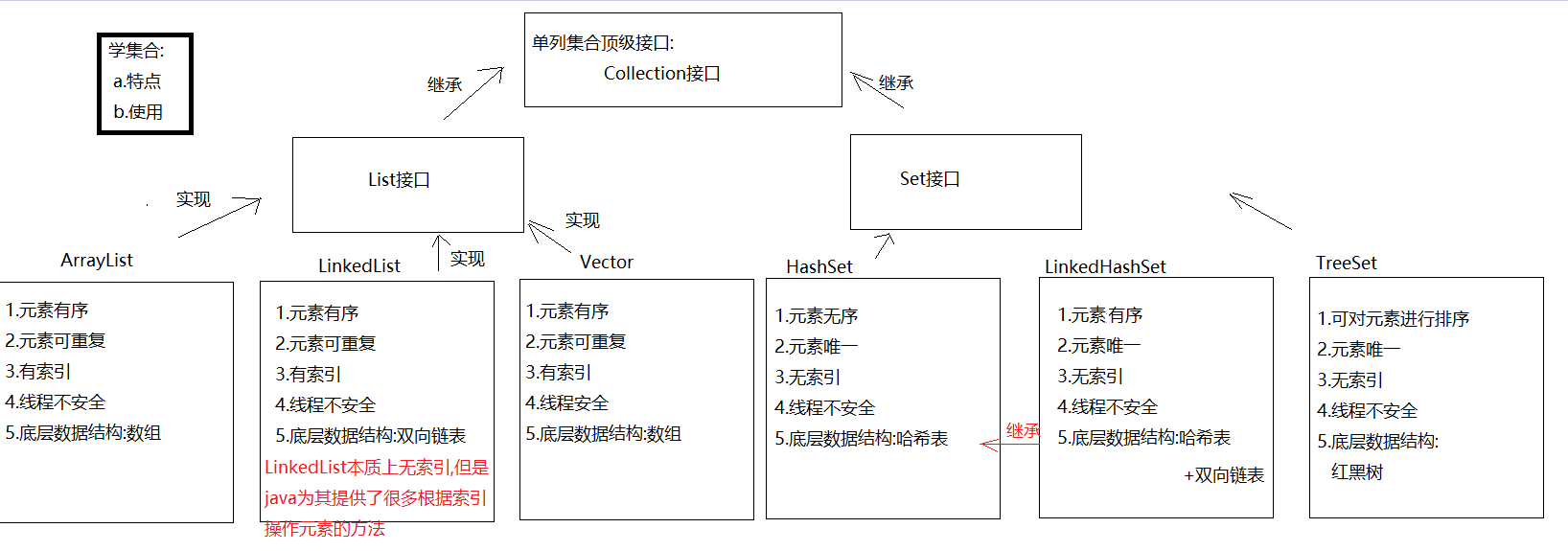
第二章.Collection接口
1
2
3
4
5
6
7
8
9
10
11
12
13
14
15
16
17
18
19
20
21
22
23
|
1.概述:单列集合的顶级接口
2.使用:
a.创建:
Collection<E> 对象名 = new 实现类对象<E>()
b.<E>:泛型,决定了集合中能存储什么类型的数据,可以统一元素类型
泛型中只能写引用数据类型,如果不写,默认Object类型,此时什么类型的数据都可以存储了
<int> 不行
<Integer> 行
<Person> 行
可推导的就是可省略的。
c.泛型细节:
我们等号前面的泛型必须写,等号后面的泛型可以不写,jvm会根据前面的泛型推导出后面的泛型是啥
3.常用方法:
boolean add(E e) : 将给定的元素添加到当前集合中(我们一般调add时,不用boolean接收,因为add一定会成功)
boolean addAll(Collection<? extends E> c) :将另一个集合元素添加到当前集合中 (集合合并)
void clear():清除集合中所有的元素
boolean contains(Object o) :判断当前集合中是否包含指定的元素
boolean isEmpty() : 判断当前集合中是否有元素->判断集合是否为空
boolean remove(Object o):将指定的元素从集合中删除
int size() :返回集合中的元素个数。
Object[] toArray(): 把集合中的元素,存储到数组中
|
1
2
3
4
5
6
7
8
9
10
11
12
13
14
15
16
17
18
19
20
21
22
23
24
25
26
27
28
29
30
31
32
33
34
35
36
37
38
|
public class Demo01Collection {
public static void main(String[] args) {
Collection<String> collection = new ArrayList<>();
//boolean add(E e) : 将给定的元素添加到当前集合中(我们一般调add时,不用boolean接收,因为add一定会成功)
collection.add("萧炎");
collection.add("萧薰儿");
collection.add("彩鳞");
collection.add("小医仙");
collection.add("云韵");
collection.add("涛哥");
System.out.println(collection);
//boolean addAll(Collection<? extends E> c) :将另一个集合元素添加到当前集合中 (集合合并)
Collection<String> collection1 = new ArrayList<>();
collection1.add("张无忌");
collection1.add("小昭");
collection1.add("赵敏");
collection1.add("周芷若");
collection1.addAll(collection);
System.out.println(collection1);
//void clear():清除集合中所有的元素
collection1.clear();
System.out.println(collection1);
//boolean contains(Object o) :判断当前集合中是否包含指定的元素
boolean result01 = collection.contains("涛哥");
System.out.println("result01 = " + result01);
//boolean isEmpty() : 判断当前集合中是否有元素->判断集合是否为空
System.out.println(collection1.isEmpty());
//boolean remove(Object o):将指定的元素从集合中删除
collection.remove("涛哥");
System.out.println(collection);
//int size() :返回集合中的元素个数。
System.out.println(collection.size());
//Object[] toArray(): 把集合中的元素,存储到数组中
Object[] arr = collection.toArray();
System.out.println(Arrays.toString(arr));
}
}
|
第三章.迭代器
1.迭代器基本使用
1
2
3
4
5
6
7
|
1.概述:Iterator接口
2.主要作用:遍历集合
3.获取:Collection中的方法:
Iterator<E> iterator()
4.方法:
boolean hasNext() -> 判断集合中有没有下一个元素
E next() ->获取下一个元素
|
1
2
3
4
5
6
7
8
9
10
11
12
13
14
15
16
|
public class Demo01Iterator {
public static void main(String[] args) {
ArrayList<String> list = new ArrayList<>();
list.add("楚雨荨");
list.add("慕容云海");
list.add("端木磊");
list.add("上官瑞谦");
list.add("叶烁");
//获取迭代器对象
Iterator<String> iterator = list.iterator();
while(iterator.hasNext()){
String element = iterator.next();
System.out.println(element);
}
}
}
|
注意:next方法在获取的时候不要连续使用多次
1
2
3
4
5
6
7
8
9
10
11
12
13
14
15
16
17
18
|
public class Demo02Iterator {
public static void main(String[] args) {
ArrayList<String> list = new ArrayList<>();
list.add("楚雨荨");
list.add("慕容云海");
list.add("端木磊");
list.add("上官瑞谦");
list.add("叶烁");
//获取迭代器对象
Iterator<String> iterator = list.iterator();
while(iterator.hasNext()){
String element = iterator.next();
System.out.println(element);
//String element2 = iterator.next();
//System.out.println(element2);
}
}
}
|
NoSuchElementException:没有可操作的元素异常
2.迭代器迭代过程
1
2
|
int cursor; //下一个元素索引位置
int lastRet = -1;//上一个元素索引位置
|

3.迭代器底层原理
1
2
3
4
|
1.获取Iterator的时候怎么获取的:
Iterator iterator = list.iterator()
我们知道Iterator是一个接口,等号右边一定是它的实现类对象
问题:Iterator接收的到底是哪个实现类对象呢? -> ArrayList中的内部类Itr对象
|
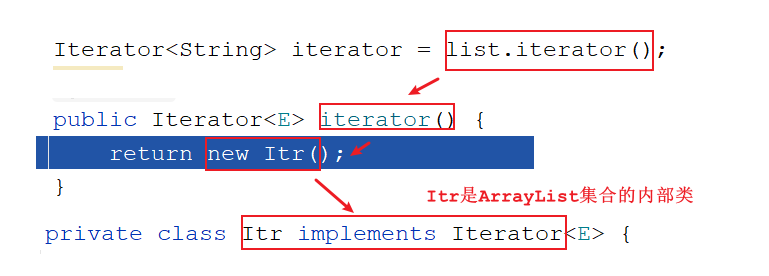
注意:只有ArrayList使用迭代器的时候Iterator接口才会指向Itr,其他的集合使用迭代器Iterator就指向的不是Itr了
1
2
|
HashSet<String> set = new HashSet<>();
Iterator<String> iterator1 = set.iterator();
|
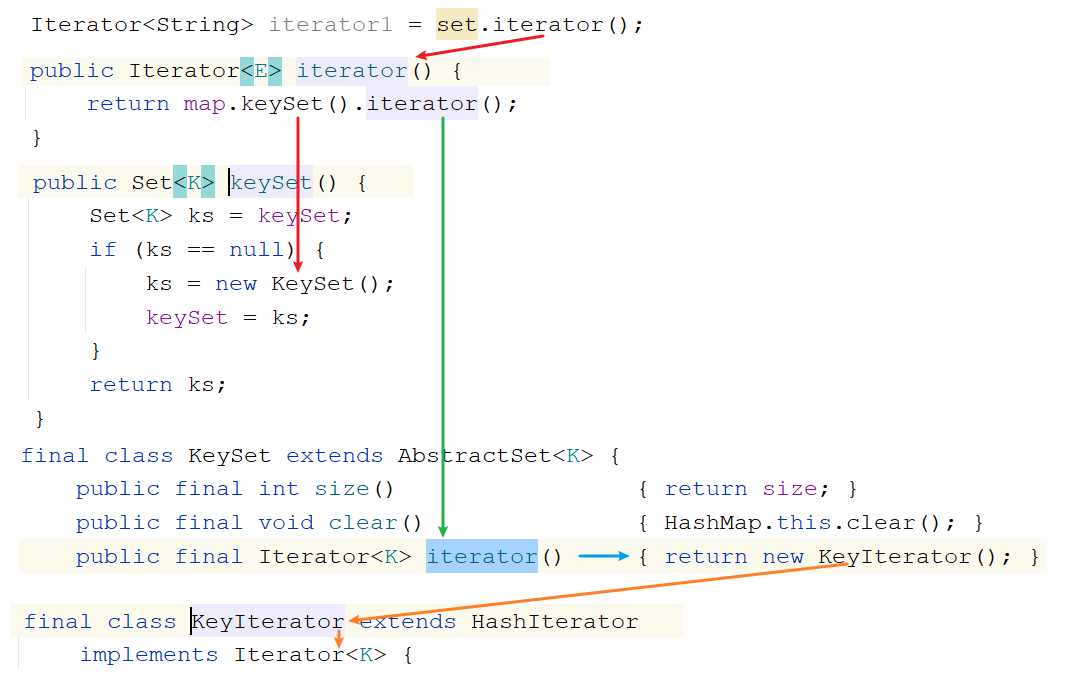
4.并发修改异常
1
|
需求:定义一个集合,存储 唐僧,孙悟空,猪八戒,沙僧,遍历集合,如果遍历到猪八戒,往集合中添加一个白龙马
|
1
2
3
4
5
6
7
8
9
10
11
12
13
14
15
16
17
18
19
|
public class Demo03Iterator {
public static void main(String[] args) {
//需求:定义一个集合,存储 唐僧,孙悟空,猪八戒,沙僧,遍历集合,如果遍历到猪八戒,往集合中添加一个白龙马
ArrayList<String> list = new ArrayList<>();
list.add("唐僧");
list.add("孙悟空");
list.add("猪八戒");
list.add("沙僧");
Iterator<String> iterator = list.iterator();
while(iterator.hasNext()){
String element = iterator.next();
if ("猪八戒".equals(element)){
list.add("白龙马");
}
}
System.out.println(list);
}
}
|

1
2
3
4
5
6
7
8
9
10
11
12
13
14
15
16
17
18
19
20
21
22
|
String element = iterator.next();
=========================================
private class Itr implements Iterator<E> {
int cursor; // index of next element to return
int lastRet = -1; // index of last element returned; -1 if no such
/*
modCount: 实际操作次数
expectedModCount:预期操作次数
*/
int expectedModCount = modCount;
@SuppressWarnings("unchecked")
public E next() {
checkForComodification();
}
final void checkForComodification() {
if (modCount != expectedModCount)
throw new ConcurrentModificationException();
}
}
|
1
|
结论:当预期操作次数和实际操作次数不相等了,会出现"并发修改异常"
|
1
|
我们干了什么事儿,让实际操作次数和预期操作次数不相等了
|
1
2
3
4
5
6
7
|
list.add("白龙马")
====================================
public boolean add(E e) {
modCount++;//实际操作次数+1
}
====================================
最终结论:我们调用了add方法,而add方法底层只给modCount++,但是再次调用next方法的时候,并没有给修改后的modCount重新赋值给expectedModCount,导致next方法底层的判断判断出实际操作次数和预期操作次数不相等了,所以抛出了"并发修改异常"
|
ArrayList中的方法:ListIterator listIterator()
1
2
3
4
5
6
7
8
9
10
11
12
13
14
15
16
17
18
19
20
|
public class Demo03Iterator {
public static void main(String[] args) {
//需求:定义一个集合,存储 唐僧,孙悟空,猪八戒,沙僧,遍历集合,如果遍历到猪八戒,往集合中添加一个白龙马
ArrayList<String> list = new ArrayList<>();
list.add("唐僧");
list.add("孙悟空");
list.add("猪八戒");
list.add("沙僧");
//Iterator<String> iterator = list.iterator();
ListIterator<String> listIterator = list.listIterator();
while(listIterator.hasNext()){
String element = listIterator.next();
if ("猪八戒".equals(element)){
listIterator.add("白龙马");
}
}
System.out.println(list);
}
}
|
使用迭代器迭代集合的过程中,不要随意修改集合长度,容易出现并发修改异常
第四章.数据结构
1
|
数据结构是一种具有一定逻辑关系,在计算机中应用某种存储结构,并且封装了相应操作的数据元素集合。它包含三方面的内容,逻辑关系、存储关系及操作。
|
为什么需要数据结构
1
|
随着应用程序变得越来越复杂和数据越来越丰富,几百万、几十亿甚至几百亿的数据就会出现,而对这么大对数据进行搜索、插入或者排序等的操作就越来越慢,数据结构就是用来解 决这些问题的。
|


数据的逻辑结构指反映数据元素之间的逻辑关系,而与他们在计算机中的存储位置无关:
- 集合(数学中集合的概念):数据结构中的元素之间除了“同属一个集合” 的相互关系外,别无其他关系;
- 线性结构:数据结构中的元素存在一对一的相互关系;
- 树形结构:数据结构中的元素存在一对多的相互关系;
- 图形结构:数据结构中的元素存在多对多的相互关系。
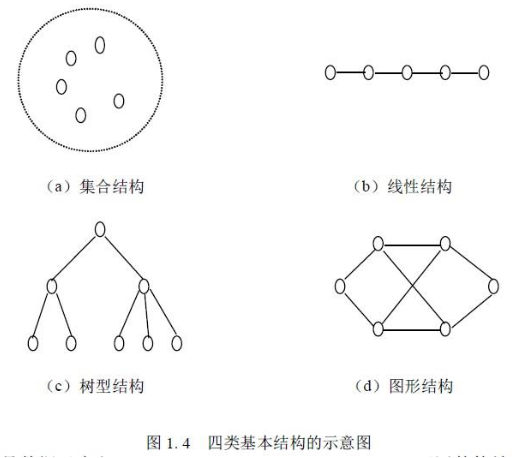
数据的物理结构/存储结构:是描述数据具体在内存中的存储(如:顺序结构、链式结构、索引结构、哈希结构)等,一种数据逻辑结构可表示成一种或多种物理存储结构。
数据结构是一门完整并且复杂的课程,那么我们今天只是简单的讨论常见的几种数据结构,让我们对数据结构与算法有一个初步的了解。
1.栈
1
2
3
|
1.特点:
先进后出
2.好比:手枪压子弹
|
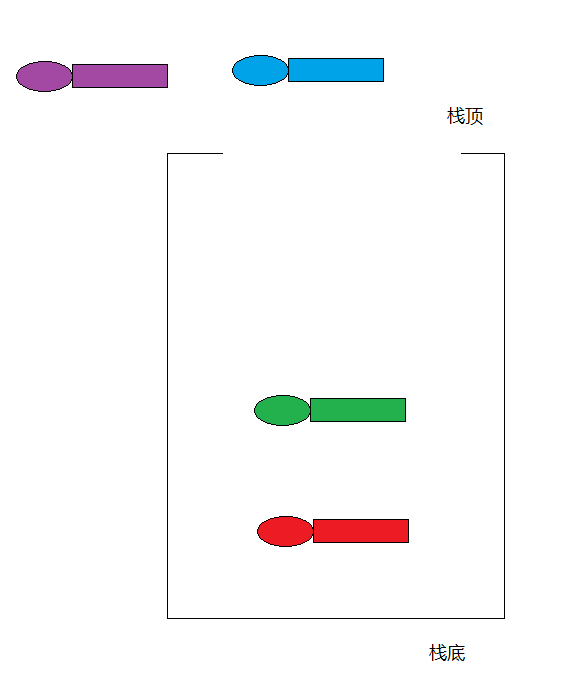
2.队列

3.数组
1
2
3
4
5
6
7
|
1.特点:查询快,增删慢
2.查询快:因为有索引,我们可以直接通过索引操作元素
增删慢:因为数组定长
a.添加元素:创建新数组,将老数组中的元素复制到新数组中去,在最后添加新元素;要是从中间插入就更麻烦了
插入完新元素,后面的元素都要往后移动
b.删除元素:创建新数组,将老数组中的元素复制到新数组中去,被删除的元素就不复制了;如果要是从之间删除
被删除的元素后面的元素都要往前移动
|
4.链表
1
2
3
4
5
6
7
8
9
10
11
12
13
14
15
16
|
1.在集合中涉及到了两种链表
2.单向链表
a.节点:一个节点分为两部分
第一部分:数据域(存数据)
第二部分:指针域(保存下一个节点地址)
b.特点:前面节点记录后面节点的地址,但是后面节点地址不记录前面节点地址
3.双向链表:
a.节点:一个节点分为三部分
第一部分:指针域(保存上一个节点地址)
第二部分:数据域(保存的数据)
第三部分:指针域(保存下一个节点地址)
b.特点:
前面节点记录后面节点地址,后面节点也记录前面节点地址
4.链表结构特点:查询慢,增删快
|
4.1单向链表
1
2
3
4
|
a.节点:一个节点分为两部分
第一部分:数据域(存数据)
第二部分:指针域(保存下一个节点地址)
b.特点:前面节点记录后面节点的地址,但是后面节点地址不记录前面节点地址
|
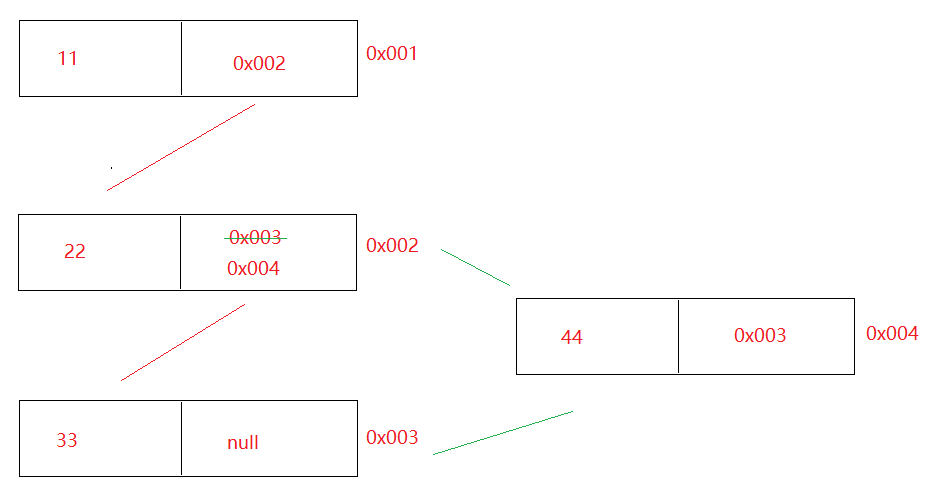
4.2双向链表
1
2
3
4
5
6
|
a.节点:一个节点分为三部分
第一部分:指针域(保存上一个节点地址)
第二部分:数据域(保存的数据)
第三部分:指针域(保存下一个节点地址)
b.特点:
前面节点记录后面节点地址,后面节点也记录前面节点地址
|

第五章.List接口
1
2
3
|
1.概述:是Collection接口的子接口
2.常见的实现类:
ArrayList LinkedList Vector
|
第六章.List集合下的实现类
1.ArrayList集合
1
2
3
4
5
6
7
8
9
10
11
12
13
14
15
16
|
1.概述:ArrayList是List接口的实现类
2.特点:
a.元素有序-> 按照什么顺序存的,就按照什么顺序取
b.元素可重复
c.有索引-> 可以利用索引去操作元素
d.线程不安全
3.数据结构:数组
4.常用方法:
boolean add(E e) -> 将元素添加到集合中->尾部(add方法一定能添加成功的,所以我们不用boolean接收返回值)
void add(int index, E element) ->在指定索引位置上添加元素
boolean remove(Object o) ->删除指定的元素,删除成功为true,失败为false
E remove(int index) -> 删除指定索引位置上的元素,返回的是被删除的那个元素
E set(int index, E element) -> 将指定索引位置上的元素,修改成后面的element元素
E get(int index) -> 根据索引获取元素
int size() -> 获取集合元素个数
|
1.1.ArrayList集合使用
1
2
3
4
5
6
7
8
9
10
11
12
13
14
15
16
17
18
19
20
21
22
23
24
25
26
27
28
29
30
|
public class Demo01ArrayList {
public static void main(String[] args) {
ArrayList<String> list = new ArrayList<>();
//boolean add(E e) -> 将元素添加到集合中->尾部(add方法一定能添加成功的,所以我们不用boolean接收返回值)
list.add("铁胆火车侠");
list.add("喜洋洋");
list.add("火影忍者");
list.add("灌篮高手");
list.add("网球王子");
System.out.println(list);
//void add(int index, E element) ->在指定索引位置上添加元素
list.add(2,"涛哥");
System.out.println(list);
//boolean remove(Object o) ->删除指定的元素,删除成功为true,失败为false
list.remove("涛哥");
System.out.println(list);
//E remove(int index) -> 删除指定索引位置上的元素,返回的是被删除的那个元素
String element = list.remove(0);
System.out.println(element);
System.out.println(list);
//E set(int index, E element) -> 将指定索引位置上的元素,修改成后面的element元素
String element2 = list.set(0, "金莲");
System.out.println(element2);
System.out.println(list);
//E get(int index) -> 根据索引获取元素
System.out.println(list.get(0));
//int size() -> 获取集合元素个数
System.out.println(list.size());
}
}
|
1
2
3
4
5
6
7
8
9
10
11
12
13
14
15
16
17
18
19
20
21
22
23
24
25
26
27
28
29
30
31
|
public class Demo02ArrayList {
public static void main(String[] args) {
ArrayList<String> list = new ArrayList<>();
list.add("铁胆火车侠");
list.add("喜洋洋");
list.add("火影忍者");
list.add("灌篮高手");
list.add("网球王子");
Iterator<String> iterator = list.iterator();
while(iterator.hasNext()){
System.out.println(iterator.next());
}
System.out.println("=====================");
for (int i = 0;i<list.size();i++){
System.out.println(list.get(i));
}
System.out.println("=====================");
/*
遍历带有索引集合的快捷键
集合名.fori
*/
for (int i = 0; i < list.size(); i++) {
System.out.println(list.get(i));
}
}
}
|
1
2
3
4
5
6
7
8
9
10
11
12
13
14
15
16
17
18
19
20
21
22
23
|
public class Demo03ArrayList {
public static void main(String[] args) {
ArrayList<Integer> list = new ArrayList<>();
list.add(2);
System.out.println(list);
/*
需求:删除2
remove(Object o) -> 直接删除指定元素
remove(int index) -> 删除指定索引位置上的元素
如果remove中直接传递整数,默认调用按照指定索引删除元素的remove
但是此时list中没有2索引,所以越界
解决:我们可以将2包装成包装类,变成包装类之后,其父类就是Object了,
*/
//list.remove(2);
list.remove(Integer.valueOf(2));
System.out.println(list);
}
}
|
1.2.底层源码分析
1
2
3
4
5
6
7
8
9
10
|
1.ArrayList构造方法:
a.ArrayList() 构造一个初始容量为十的空列表
b.ArrayList(int initialCapacity) 构造具有指定初始容量的空列表
2.ArrayList源码总结:
a.不是一new底层就会创建初始容量为10的空列表,而是第一次add的时候才会创建初始化容量为10的空列表
b.ArrayList底层是数组,那么为啥还说集合长度可变呢?
ArrayList底层会自动扩容-> Arrays.copyOf
c.扩容多少倍?
1.5倍
|
1
2
3
4
5
6
7
8
9
10
11
12
13
14
15
16
17
18
19
20
21
22
23
24
25
26
27
28
29
30
31
32
33
34
35
36
37
38
39
40
41
42
43
44
45
46
47
48
49
50
51
52
53
54
55
56
57
58
59
60
61
62
63
64
65
66
67
68
69
|
ArrayList() 构造一个初始容量为十的空列表
=========================================
private static final Object[] DEFAULTCAPACITY_EMPTY_ELEMENTDATA = {};
Object[] elementData; ->ArrayList底层的那个数组
public ArrayList() {
this.elementData = DEFAULTCAPACITY_EMPTY_ELEMENTDATA;
}
=========================================
list.add("a");
public boolean add(E e) {
modCount++;
add(e, elementData, size);// e->要存的元素 elementData->集合数组,长度开始为0,size->0
return true;
}
private void add(E e->元素, Object[] elementData->集合数组, int s->0) {
if (s == elementData.length)
elementData = grow();
elementData[s] = e;
size = s + 1;
}
private Object[] grow() {
return grow(size + 1);
}
private Object[] grow(int minCapacity->1) {
int oldCapacity = elementData.length;//0
if (oldCapacity > 0 || elementData != DEFAULTCAPACITY_EMPTY_ELEMENTDATA) {
int newCapacity = ArraysSupport.newLength(oldCapacity,
minCapacity - oldCapacity, /* minimum growth */
oldCapacity >> 1 /* preferred growth */);
return elementData = Arrays.copyOf(elementData, newCapacity);
} else {
return elementData = new Object[Math.max(DEFAULT_CAPACITY->10, minCapacity->1)];
}
}
==========================================
假设ArrayList中存了第11个元素,会自动扩容-> Arrays.copyOf
private Object[] grow(int minCapacity) {//11
int oldCapacity = elementData.length;//10
if (oldCapacity > 0 || elementData != DEFAULTCAPACITY_EMPTY_ELEMENTDATA) {
int newCapacity(15) = ArraysSupport.newLength(oldCapacity->10,
minCapacity - oldCapacity->1, /* minimum growth */
oldCapacity >> 1 ->5 /* preferred growth */);
return elementData = Arrays.copyOf(elementData, newCapacity);
} else {
return elementData = new Object[Math.max(DEFAULT_CAPACITY, minCapacity)];
}
}
public static int newLength(int oldLength->10, int minGrowth->1, int prefGrowth->5) {
// preconditions not checked because of inlining
// assert oldLength >= 0
// assert minGrowth > 0
int prefLength = oldLength + Math.max(minGrowth, prefGrowth); // 15
if (0 < prefLength && prefLength <= SOFT_MAX_ARRAY_LENGTH) {
return prefLength;
} else {
// put code cold in a separate method
return hugeLength(oldLength, minGrowth);
}
}
|
1
|
ArrayList(int initialCapacity) 构造具有指定初始容量的空列表
|
1
2
3
4
5
6
7
8
9
10
11
12
|
ArrayList<String> list = new ArrayList<>(5);
==============================================
public ArrayList(int initialCapacity->5) {
if (initialCapacity > 0) {
this.elementData = new Object[initialCapacity];//直接创建长度为5的数组
} else if (initialCapacity == 0) {
this.elementData = EMPTY_ELEMENTDATA;
} else {
throw new IllegalArgumentException("Illegal Capacity: "+
initialCapacity);
}
}
|
ArrayList list = new ArrayList() -> 现在我们想用都是new
但是将来开发不会想使用就new集合,都是调用一个方法,查询出很多数据来,此方法返回一个集合,自动将查询出来的数据放到集合中,我们想在页面上展示数据,遍历集合
而且将来调用方法,返回的集合类型,一般都是接口类型
List<泛型> list = 对象.查询方法()
第七章.LinkedList集合
1
2
3
4
5
6
7
8
9
10
11
12
13
14
15
16
17
18
19
|
1.概述:LinkedList是List接口的实现类
2.特点:
a.元素有序
b.元素可重复
c.有索引 -> 这里说的有索引仅仅指的是有操作索引的方法,不代表本质上具有索引
d.线程不安全
3.数据结构:双向链表
4.方法:有大量直接操作首尾元素的方法
- public void addFirst(E e):将指定元素插入此列表的开头。
- public void addLast(E e):将指定元素添加到此列表的结尾。
- public E getFirst():返回此列表的第一个元素。
- public E getLast():返回此列表的最后一个元素。
- public E removeFirst():移除并返回此列表的第一个元素。
- public E removeLast():移除并返回此列表的最后一个元素。
- public E pop():从此列表所表示的堆栈处弹出一个元素。
- public void push(E e):将元素推入此列表所表示的堆栈。
- public boolean isEmpty():如果列表没有元素,则返回true。
|
1
2
3
4
5
6
7
8
9
10
11
12
13
14
15
16
17
18
19
20
21
22
23
24
25
26
27
28
29
30
31
32
33
34
35
36
37
38
|
public class Demo05LinkedList {
public static void main(String[] args) {
LinkedList<String> linkedList = new LinkedList<>();
linkedList.add("吕布");
linkedList.add("刘备");
linkedList.add("关羽");
linkedList.add("张飞");
linkedList.add("貂蝉");
System.out.println(linkedList);
linkedList.addFirst("孙尚香");
System.out.println(linkedList);
linkedList.addLast("董卓");
System.out.println(linkedList);
System.out.println(linkedList.getFirst());
System.out.println(linkedList.getLast());
linkedList.removeFirst();
System.out.println(linkedList);
linkedList.removeLast();
System.out.println(linkedList);
System.out.println("======================");
Iterator<String> iterator = linkedList.iterator();
while(iterator.hasNext()){
System.out.println(iterator.next());
}
System.out.println("=======================");
for (int i = 0; i < linkedList.size(); i++) {
System.out.println(linkedList.get(i));
}
}
}
|
1
2
|
public E pop():从此列表所表示的堆栈处弹出一个元素。
public void push(E e):将元素推入此列表所表示的堆栈。
|
1
2
3
4
5
6
7
8
9
10
11
12
13
14
15
16
17
|
public class Demo06LinkedList {
public static void main(String[] args) {
LinkedList<String> linkedList = new LinkedList<>();
linkedList.add("吕布");
linkedList.add("刘备");
linkedList.add("关羽");
linkedList.add("张飞");
linkedList.add("貂蝉");
//public E pop():从此列表所表示的堆栈处弹出一个元素。
linkedList.pop();
System.out.println(linkedList);
//public void push(E e):将元素推入此列表所表示的堆栈。
linkedList.push("涛哥");
System.out.println(linkedList);
}
}
|
1.1 LinkedList底层成员解释说明
1
2
3
4
5
6
7
8
9
10
11
12
13
14
15
16
17
|
1.LinkedList底层成员
transient int size = 0; 元素个数
transient Node<E> first; 第一个节点对象
transient Node<E> last; 最后一个节点对象
2.Node代表的是节点对象
private static class Node<E> {
E item;//节点上的元素
Node<E> next;//记录着下一个节点地址
Node<E> prev;//记录着上一个节点地址
Node(Node<E> prev, E element, Node<E> next) {
this.item = element;
this.next = next;
this.prev = prev;
}
}
|
1.2 LinkedList中add方法源码分析
1
2
3
4
5
6
7
8
9
10
11
12
13
14
15
|
LinkedList<String> list = new LinkedList<>();
list.add("a");
list.add("b");
void linkLast(E e) {
final Node<E> l = last;
final Node<E> newNode = new Node<>(l, e, null);
last = newNode;
if (l == null)
first = newNode;
else
l.next = newNode;
size++;
modCount++;
}
|

1.3.LinkedList中get方法源码分析
1
2
3
4
5
6
7
8
9
10
11
12
13
14
15
16
17
18
19
20
|
public E get(int index) {
checkElementIndex(index);
return node(index).item;
}
Node<E> node(int index) {
// assert isElementIndex(index);
if (index < (size >> 1)) {
Node<E> x = first;
for (int i = 0; i < index; i++)
x = x.next;
return x;
} else {
Node<E> x = last;
for (int i = size - 1; i > index; i--)
x = x.prev;
return x;
}
}
|
1
|
index < (size >> 1)采用二分思想,先将index与长度size的一半比较,如果index<size/2,就只从位置0往后遍历到位置index处,而如果index>size/2,就只从位置size往前遍历到位置index处。这样可以减少一部分不必要的遍历
|
第八章.增强for
1.基本使用
1
2
3
4
5
6
7
8
|
1.作用:
遍历集合或者数组
2.格式:
for(元素类型 变量名:要遍历的集合名或者数组名){
变量名就是代表的每一个元素
}
3.快捷键:集合名或者数组名.for
|
1
2
3
4
5
6
7
8
9
10
11
12
13
14
15
16
17
18
19
|
public class Demo01ForEach {
public static void main(String[] args) {
ArrayList<String> list = new ArrayList<>();
list.add("张三");
list.add("李四");
list.add("王五");
list.add("赵六");
for (String s : list) {
System.out.println(s);
}
System.out.println("=====================");
int[] arr = {1,2,3,4,5};
for (int i : arr) {
System.out.println(i);
}
}
}
|
2.注意
1
2
|
1.增强for遍历集合时,底层实现原理为迭代器
2.增强for遍历数组时,底层实现原理为普通for
|
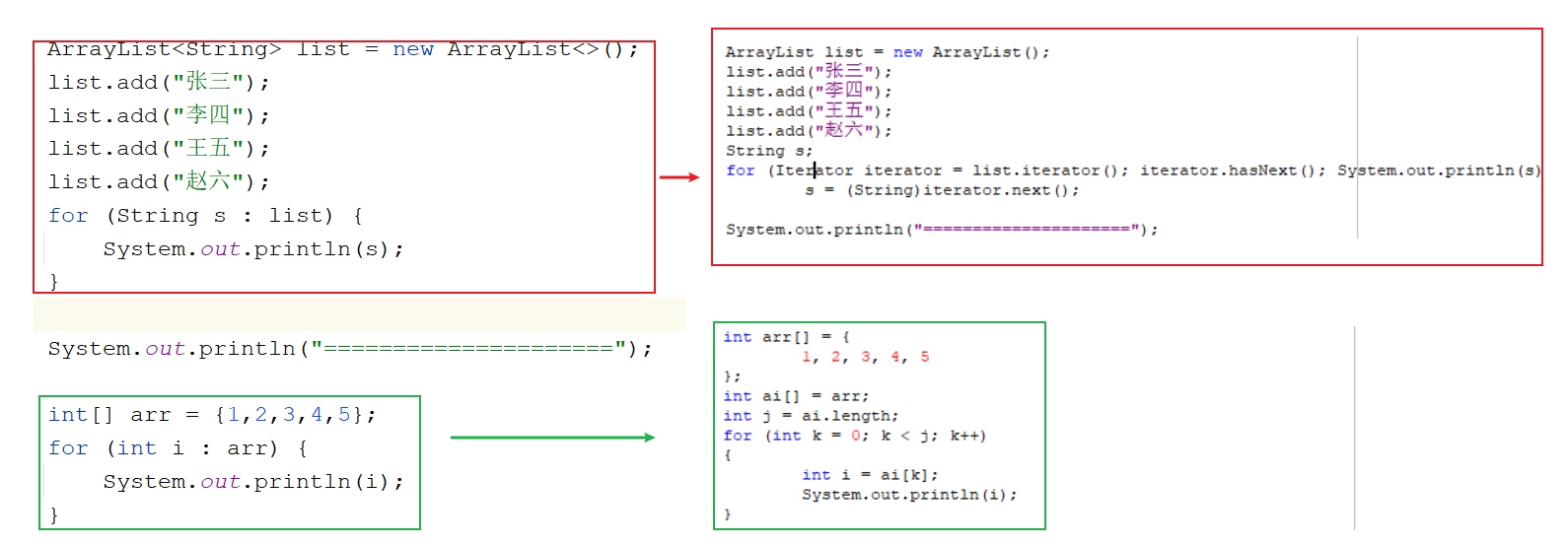
所以不管是用迭代器还是使用增强for,在遍历集合的过程中都不要随意修改集合长度,否则会出现并发修改异常













